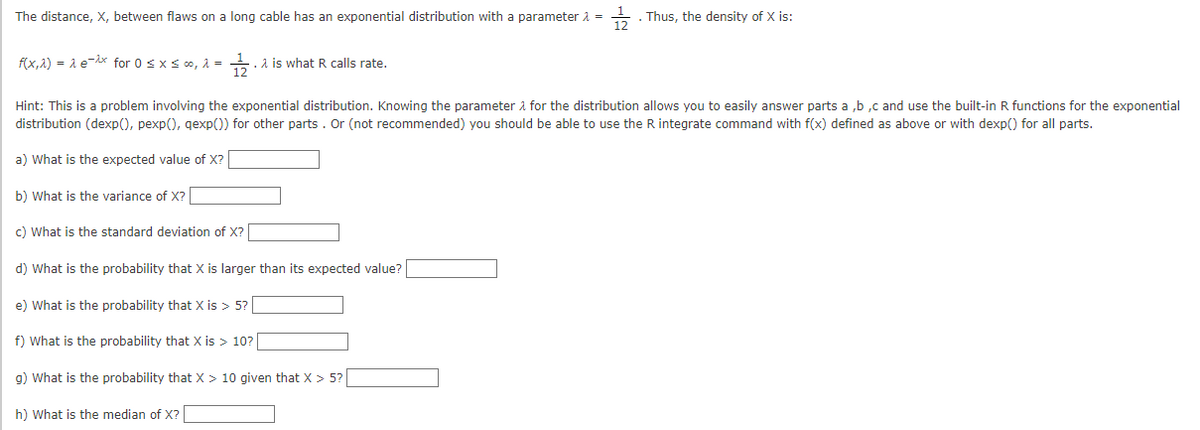d) What is the probability that X is larger than its expected value? e) What is the probability that X is > 5? f) What is the probability that X is> 10?
d) What is the probability that X is larger than its expected value? e) What is the probability that X is > 5? f) What is the probability that X is> 10?
Algebra & Trigonometry with Analytic Geometry
13th Edition
ISBN:9781133382119
Author:Swokowski
Publisher:Swokowski
Chapter10: Sequences, Series, And Probability
Section: Chapter Questions
Problem 27T
Related questions
Question
i need solution of part d , e , f ,g , h

Transcribed Image Text:The distance, X, between flaws on a long cable has an exponential distribution with a parameter > =
1/2
f(x,^) = λ ex for 0 ≤ x ≤ ∞, λ =
e) What is the probability that X is > 5?
. λ is what R calls rate.
Hint: This is a problem involving the exponential distribution. Knowing the parameter for the distribution allows you to easily answer parts a,b,c and use the built-in R functions for the exponential
distribution (dexp(), pexp(), qexp()) for other parts. Or (not recommended) you should be able to use the R integrate command with f(x) defined as above or with dexp() for all parts.
a) What is the expected value of X?
b) What is the variance of X?
c) What is the standard deviation of X?
d) What is the probability that X is larger than its expected value?
f) What is the probability that X is > 10?
. Thus, the density of X is:
g) What is the probability that X > 10 given that X > 5?
h) What is the median of X?
Expert Solution
This question has been solved!
Explore an expertly crafted, step-by-step solution for a thorough understanding of key concepts.
Step by step
Solved in 4 steps with 3 images

Follow-up Questions
Read through expert solutions to related follow-up questions below.
Follow-up Question
gand h using r language

Transcribed Image Text:The distance, X, between flaws on a long cable has an exponential distribution with a parameter > =
1/2
f(x,^) = λ ex for 0 ≤ x ≤ ∞, λ =
e) What is the probability that X is > 5?
. λ is what R calls rate.
Hint: This is a problem involving the exponential distribution. Knowing the parameter for the distribution allows you to easily answer parts a,b,c and use the built-in R functions for the exponential
distribution (dexp(), pexp(), qexp()) for other parts. Or (not recommended) you should be able to use the R integrate command with f(x) defined as above or with dexp() for all parts.
a) What is the expected value of X?
b) What is the variance of X?
c) What is the standard deviation of X?
d) What is the probability that X is larger than its expected value?
f) What is the probability that X is > 10?
. Thus, the density of X is:
g) What is the probability that X > 10 given that X > 5?
h) What is the median of X?
Solution
Recommended textbooks for you

Algebra & Trigonometry with Analytic Geometry
Algebra
ISBN:
9781133382119
Author:
Swokowski
Publisher:
Cengage

Algebra & Trigonometry with Analytic Geometry
Algebra
ISBN:
9781133382119
Author:
Swokowski
Publisher:
Cengage